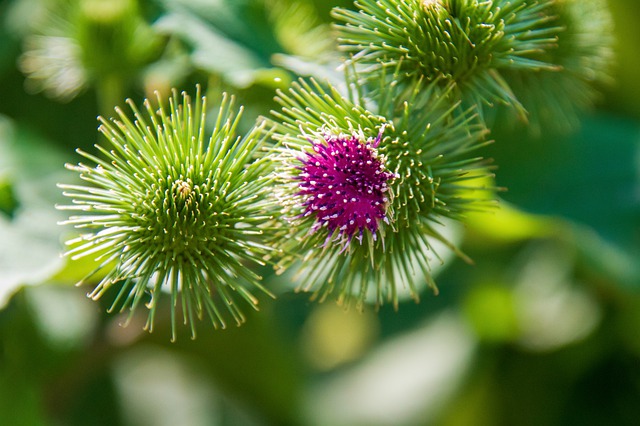Burdock Root

Introduction Considered by many in the North America and Europe as a common weed, burdock is a sturdy biennial plant reaching up to 6 feet (2 m) high, with 18 inch (50 cm) wide leaves forming a rosette at ground level, with smaller versions growing up the thick flowering stem. Burdocks roots grow straight down as much as 3 feet (1M) into the subsoil. In mid-summer, the plant blossoms into a dense array of globular flowers with sticky bracts that cling to passing animals and peoples. These burs were in fact the inspiration behind the invention of Velcro fasters, when the inventor found them sticking to his dog after an afternoon walk and he realized that objects could be fastened together in the same fashion. The plant grows on roadsides and waste places and around field boundaries throughout Britain, Europe and North America; it is cultivated in Japan, where it is called gobo, and the root is consumed as an everyday vegetable, similar to a carrot.
Constituents Up to 50% inulin, polyacetylenes, volatile acids (acetic, proprionic, butyric, isovaleric), non-hydroxyl acids (lauric, myristic, stearic, palmitic), polyphenolic acids, and tannins.
Parts Used The washed and dried root, powdered. Also, sometimes the fruits and leaves.
Typical Preparations It is best taken as a tea in a decoction form. May also be taken as a capsule or extract. In Asia it is used as an ingredient in soups, stews, stir fry's and even eaten raw.
Summary Native Americans were known to use the whole plant as food, boiling the root in maple syrup (which made it like candy) so that it could be stored for longer periods of time. Noted 17th century herbalist Nicholas Culpepper said that it was good for ulcers and sores, as well a treatment for someone bitten by a rabid dog. In China it is used as an aphrodisiac and for impotence. There is considerable evidence in the scientific literature that burdock root tea is a powerful anti-inflammatory remedy. Its numerous antioxidants protect the liver from toxic chemicals, allowing it to process the body's naturally occurring steroids which are helpful in achieving hormonal balance. A mildly bitter herb, it stimulates the release of gastric juices and aids digestion. This combination of qualities explains its traditional use in treating acne, eczema, endometriosis, psoriasis, and uterine fibroids. The tea can also be used as a wash to treat skin infections, eczema, and psoriasis.
Precautions Safe for use as a food or herb.
For educational purposes only. This information has not been evaluated by the Food and Drug Administration. This information is not intended to diagnose, treat, cure, or prevent any disease.
This information courtesy of MOUNTAIN ROSE HERBS, with full, written permission for reuse. For further traditional information concerning Burdock Root, please visit this excellent resource from Botanical.com. Used with full, written permission.






